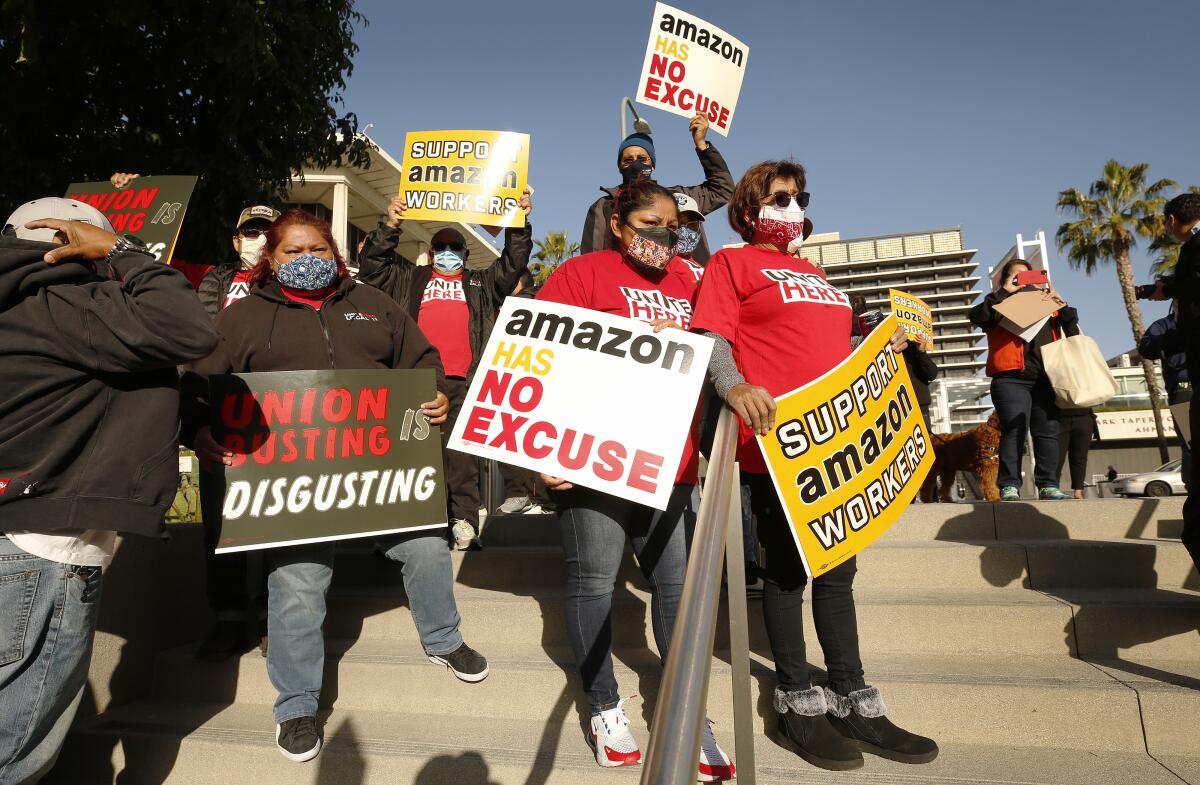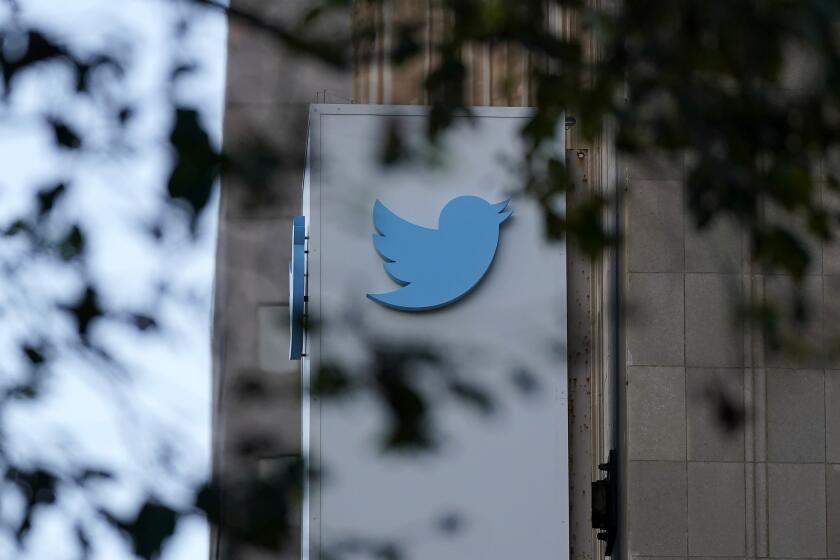Column: The real aim of big tech’s layoffs: bringing workers to heel

- Share via
In Silicon Valley, the new year began as the last one ended — with tens of thousands of tech workers losing their jobs. Just a few days into 2023, Amazon Chief Executive Andrew Jassy announced that there would be 18,000 layoffs across the company. Within weeks, Microsoft revealed it was slashing its head count by 10,000 and Google said that it was terminating 12,000 employees. IBM looks to be next, with nearly 4,000 workers on the chopping block.
This follows 2022’s bloodbath, when tens of thousands of jobs were lost at Meta Platforms, Twitter and Salesforce. According to an industry layoff tracker, the tech sector has eliminated some 220,000 jobs since the start of last year. If the laid-off tech workers formed a city, it’d be one of the most populous in the United States, bigger than Des Moines or Salt Lake City.
The question is: Why have many of the most profitable companies of our generation — most of which are still very much profitable — announced staggering rounds of layoffs, one after the other? And why now?
A common refrain from analysts and reporters is that the companies are “tightening their belts” after profligate pandemic hiring sprees, in order to streamline operations. The executives overseeing the cuts, for their part, cite adverse economic circumstances. “We hired for a different economic reality than the one we face today,” Google CEO Sundar Pichai said in his layoff announcement. Jassy wrote that “Amazon has weathered uncertain and difficult economies in the past, and we will continue to do so.” Microsoft’s Satya Nadella noted that “some parts of the world are in a recession and other parts are anticipating one.”
No recession has yet hit the U.S. or its tech sector. Inflation hurts, but the U.S. economy added hundreds of thousands of jobs last month. Still, certain shareholders have been vocal about their desire to see head counts trimmed — and trimmed further still.
To that end, critics argue that simple greed is driving the layoffs; they point to the tens of billions’ worth of stock buybacks the tech companies authorized last year. The Verge’s Elizabeth Lopatto spoke with industry analysts who said that tech companies are evaluating their bottom lines differently, and concluded that they’re doing layoffs mostly because everyone else is, even though layoffs actually often cost a given company money. And the fact all these layoffs are happening in such rapid succession gives the companies some cover — making them seem elemental, inevitable.
As tech giants lay off scores of workers amid a sector-wide downturn, employees who once considered the Silicon Valley companies a safe long-term bet are reconsidering their allegiances.
So what’s really going on here? The answer may actually be pretty simple.
“Controlling labor costs via periodic layoffs is like breathing for Silicon Valley: cyclical, necessary for life,” Malcolm Harris, author of the forthcoming book “Palo Alto: A History of California, Capitalism and the World,” told me. The layoffs, Harris says, have “very little to do with long- or even medium-term strategy except as it pertains to cultivating an insecure workforce.”
That tracks with the economic reality we do face today, as a tech CEO might put it. Because while a recession has not yet arrived in any meaningful form, there is another economic indicator pointing to the desirability of layoffs, from a large employer’s perspective: a growing effort to organize tech workers in an unusually tight labor market.
Tech employees’ salaries have skyrocketed over the last two years, and their bargaining power has begun to grow too. Over the last half-decade, workers in the tech industry have agitated for changes that executives have found increasingly inconvenient.
At Google, they’ve spoken up against gender inequalities and pressured the company to drop a lucrative defense contract. At Amazon and Microsoft, they’ve protested lackluster climate policies and spurred those companies to make pledges to reduce carbon emissions. At Facebook and Twitter, workers rallied against content moderation decisions around keeping former President Trump on the platform after Jan. 6, 2021. A subset of Google employees formed the Alphabet Workers Union with the Communication Workers of America union, Amazonians founded the Amazon Employees for Climate Justice, and at Microsoft, employees at a video game subsidiary, ZeniMax, formed the first certified union ever to be recognized by the company.
The concrete gains won by organizing tech workers so far may be relatively small, but the rising salaries and growing organizing capacity threaten the tech giants’ bottom line and the brand of executive sovereignty that’s prized in Silicon Valley. Elon Musk’s mass firings at Twitter last year, and his public demand that only “hardcore” coders dedicated to his program remain at the company, are instructive here, not least because other tech executives have said his approach was an inspiration when culling jobs at their own companies.
New Twitter owner Elon Musk is poised to cut the company’s workforce by 50%. Those employees should be in line for guaranteed severance -- unless Musk once again attempts to push the envelope of what’s legal.
Workers in an industry that had long been famously union-agnostic at best had been forming bonds, organizing and developing solidarity. Layoffs of this scale and suddenness can be a blow to that process.
Affected tech workers told me that they were struck by the randomness of the firings; senior members of staff in good standing, brilliant colleagues with sterling performance reviews, all shown the door, with little rhyme or reason. Many seemed to wonder why they were spared while their peers weren’t.
Alejandra Beatty, a technical program manager at Alphabet subsidiary Verily, told me it was “very much a surprise” when she was laid off this month. For one thing, she had known herself to be in good standing at the company. “I was high performance, considered one of the pillars of the local community in the Boulder, Colo., office. Now I’m not even allowed to go back in, not even as a visitor,” she said. Beatty was also struck by how many of those let go were performing functions crucial to keeping “core products” working.
If there’s one thing that firing people in a large-scale and seemingly random way accomplishes, it’s instilling a sense of precarity, even fear, in those who remain.
“It’s completely devastating,” said Skylar Hinnant, a senior quality assurance tester at Microsoft’s ZeniMax subsidiary, “both to the people who are laid off and their families, and their colleagues, who felt, for that day and will feel it a long time after, that they’re at risk.”
Hinnant said he knew plenty of people who lost their jobs across Microsoft — everyone does. “You can be the most important engineer at your job, you can be an awesome programmer, at the end of the day if the algorithm wants you gone you’re gone.”
The pandemic was a great time to be a tech worker, as business boomed, working remotely became standard and perks flowed like water. Now, things look less certain.
“I think it’s waking people up to some realities of what the industry is really like,” Alejandra Beatty said. “We are workers. Even though we have benefits and we are highly trained — we’re still workers. We can still arbitrarily lose our jobs like anyone else.”
Beatty had been a visible member of the AWU, advocating in media interviews for reproductive rights in the workplace. She was always civil and constructive, she says, and felt her suggestions had been well-received by management. Now she thinks a lot about whether her termination was retaliatory. Ultimately, she decided the layoffs were too large, too automated to have targeted her directly. “I think I was yet another number in whatever crazy algorithm the consulting company used to figure out the cuts,” she said.
Elsewhere, there are signs that tech workers’ hard-won progress is being rolled back. Bloomberg reported that at companies such as Twitter, Meta, Amazon and Redfin that had promised to improve staff diversity, the layoffs decimated departments responsible for diversity, equity and inclusion, or DEI, inititatives.
On Tuesday, workers for Cognizant, a major Alphabet and YouTube contractor, filed a complaint with the National Labor Relations Board that they were being retaliated against for announcing a decision to join the AWU. They say Alphabet changed its policy to make relocation to Austin, Texas, mandatory for all workers, and noncompliance would result in “voluntary termination.” This, the workers say, is against NLRB rules that state that no major policy can be changed once organizing has been made public.
The tech industry has certainly shown it will go to unsavory lengths to limit worker pay and power. In 2015, Apple, Google and other tech companies agreed to pay a $415-million settlement after a lawsuit alleged the companies had colluded to keep pay low with a “non-poaching” agreement between CEOs.
But today’s massive, department-cleaving cuts do not have to be retaliatory to register a debilitating and destabilizing effect, to help the tech giants consolidate control over their workforces and underline their precarity.
“The nice comp and all the perks,” Beatty said, “none of them are really beneficial if you’re always worrying, ‘Well, am I going to be the next to be arbitrarily let go?’ ”
The clinical cruelty through which some of the layoffs were administered often served to underline that point — Google employees showing up to work to find that their keycards had been deactivated, workers locked out of email accounts and not allowed to enter the offices again, not even to say goodbye to colleagues they had worked with for years.
The tech sector seems to be betting that these massive, algorithmically orchestrated firings will not only cut labor costs, but also once again remind increasingly empowered tech workers of their insecurity, and the power the companies still hold. It’s a bet that has historically paid off and has helped transform the tech giants into some of the most profitable companies in history.
But there’s also a chance that this time, things could be different.
“It’s very galvanizing,” Beatty said. The Alphabet Workers Union held a meeting shortly after the layoffs were announced. “More than 1,000 people joined,” she said, “and another 800 tried to sign up for it after it started. It was big enough that we broke Zoom, and couldn’t do breakout rooms.”
Hinnant, the quality assurance tester at ZeniMax, is also an organizer at the newly recognized union at Microsoft. “I think it has lit a fire under a lot of people to think about organizing,” he says. “I have friends at Microsoft and Google and across the industry and I got a lot of calls.”
And unlike in tech’s mass layoffs of the past, there is now a foundation of organized workers in place, even if it is a nascent one, with the ability to provide the Salt Lake City-sized population of displaced workers some resources and support.
One of the first things that the AWU did, Beatty says, was set up a Slack channel and Discord server where laid-off workers could connect, commiserate and share information and job leads.
“It was so incredibly helpful to have a place to go and talk with other people who were impacted,” Beatty said. “And then we had people who weren’t laid off joining in to support them, to say goodbye.”
Soon, thousands of laid-off workers were joining the channel, not just from Google, but from Meta, and all across the industry. “That was a huge help in understanding the terms, what you can and can’t do, and having that place where people are like, ‘Oh, I’m freaking out,’ and talking it through,” she said. “It may become a networking space — we let a couple recruiters in. They all need employment now, you know.”
Workers provided informal, ad-hoc counseling services and helped those who could no longer access their email, computers or HR contacts get information and answers. “When you’re struggling with what just happened, it’s good to have people who can help you with that,” Beatty said. “There are people with visas or parental leave, they’re saying, ‘How do I navigate this now?’ I was compiling some of these questions to pass along, and one guy who was here on a visa said, ‘Can you ask them how long until I get deported?’ ”
Above all, workers like Beatty and Hinnant say it’s spurring interest in further tech worker organizing. “I think this really highlights the need for the people not just in the Microsoft ecosystem, but across the industry to organize,” he says. “I think this was a wake-up call. There’s a wave coming. And there’s no stopping it.”
Beatty feels likewise; she’s still hurt by the layoff but hopes to make good use of it. “If I get nothing else out of this,” she says, “I hope to see AWU grow exponentially. Then the sacrifice will have been worth it.”










